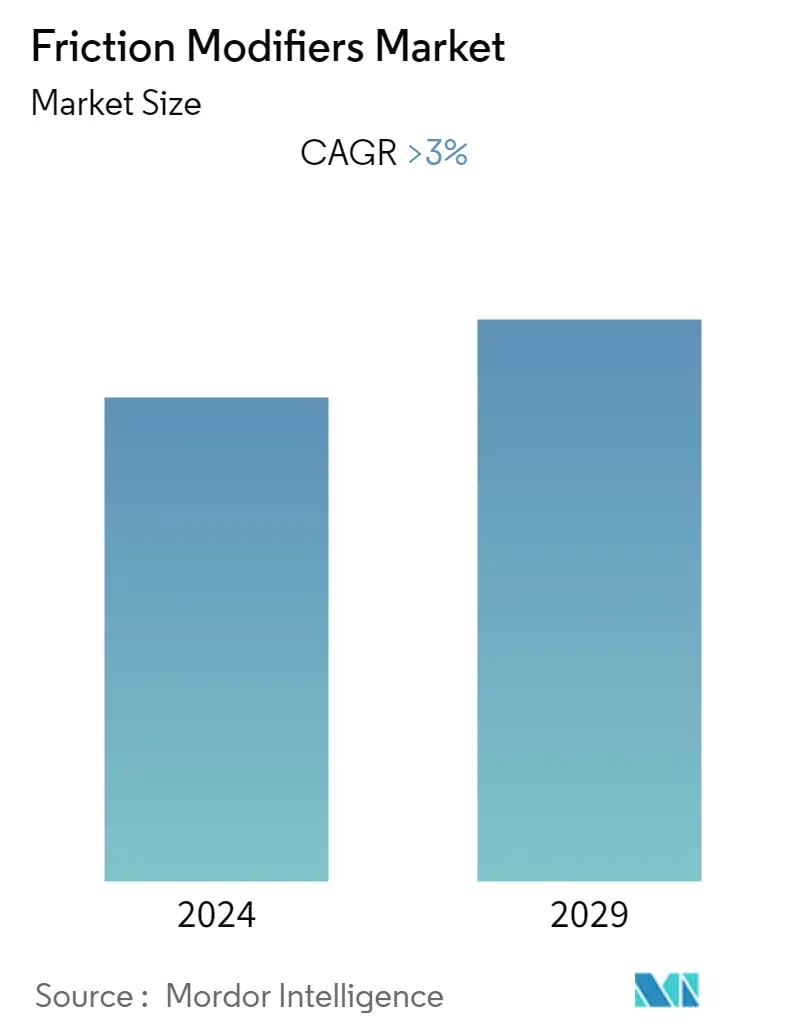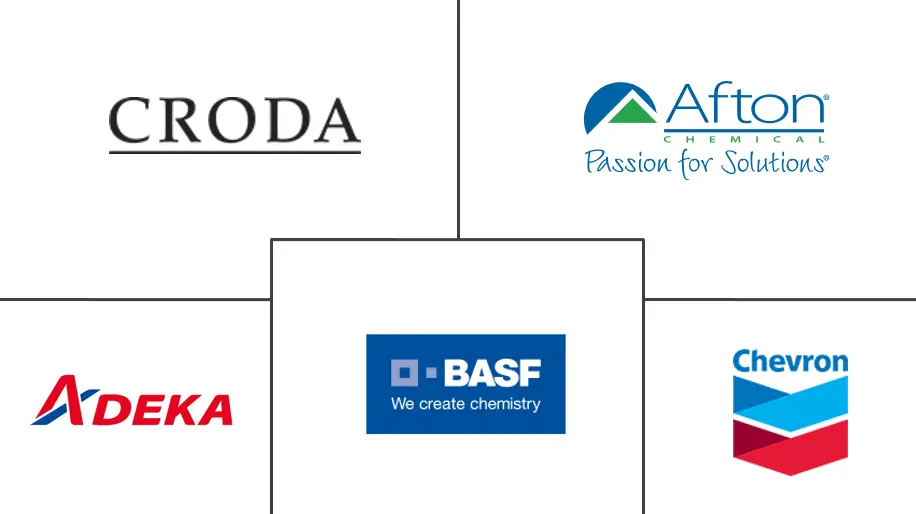Market Size of Friction Modifiers Industry

| Study Period | 2019 - 2029 |
| Base Year For Estimation | 2023 |
| CAGR | 3.00 % |
| Fastest Growing Market | Asia Pacific |
| Largest Market | Asia Pacific |
| Market Concentration | High |
Major Players
*Disclaimer: Major Players sorted in no particular order |
Friction Modifiers Market Analysis
The friction modifiers market is projected to register a CAGR of over 3% during the forecast period (2021-2026).
The market was negatively impacted by COVID-19 in 2020. Friction modifiers are additives that are mainly used in lubricants of the automotive industry. Owing to the pandemic scenario, the passenger air traveling facility was temporarily stopped during the lockdown, and even after the lockdown, people were not opting to travel frequently through airlines or personal vehicles. Thus, this led to a decrease in the consumption of aviation lubricants, as well as automobile lubricants, which, in turn, negatively impacts the demand for lubricant additives like friction modifiers.
- Over the short term, increasing applications for fuel-efficient lubricants are expected to drive the market's growth.
- The declining automotive industry, growing usage of electric vehicles, and the negative impact of the COVID-19 pandemic are expected to hinder the market's growth.
- The Asia-Pacific region is expected to dominate the market, and it is also likely to witness the highest CAGR during the forecast period.
Friction Modifiers Industry Segmentation
Friction modifiers are anti-wear additives used to minimize the friction between two contact surfaces with the modification in the coefficient of friction. A friction modifier molecules contain two different parts, one is the polar head which attaches itself to the metal surfaces, and the other is a soluble oil tail. Apart from reducing friction, they can also act as corrosion inhibitors and antioxidants. The friction modifiers market is segmented by type, end-user industry, and geography. By type, the market is segmented into organic and inorganic. By end-user industry, the market is segmented into automotive, industrial, marine, and other end-user industries. The report also covers the market size of and forecasts for the friction modifiers market in 15 countries across major regions. For each segment, the market sizing and forecasts have been done on the basis of volume (kilo tons).
| Types | |
| Organic | |
| Inorganic |
| End-user Industry | |
| Automotive | |
| Industrial | |
| Marine | |
| Other End-user Industries |
| Geography | |||||||
| |||||||
| |||||||
| |||||||
| |||||||
|
Friction Modifiers Market Size Summary
The friction modifiers market is experiencing a gradual recovery and is expected to grow steadily over the forecast period. These additives play a crucial role in enhancing the performance of lubricants used in the automotive industry by reducing friction and improving energy efficiency. The market faced challenges due to the COVID-19 pandemic, which led to a decline in demand for aviation and automobile lubricants as travel restrictions and reduced vehicle usage impacted consumption. However, the increasing demand for fuel-efficient lubricants is anticipated to drive market growth in the short term. The market's expansion is somewhat hindered by the declining automotive industry and the rise of electric vehicles, which reduce the reliance on traditional lubricants.
The Asia-Pacific region is poised to dominate the friction modifiers market, driven by its robust automotive, marine, and industrial sectors. Countries like China, India, and Japan are key players in the region, with China being a leading automobile producer globally. Despite the pandemic's impact on production and manufacturing, the region's demand for friction modifiers is expected to rise, particularly in the marine industry. The aerospace sector in Asia-Pacific also contributes to the increased usage of these additives, as they help improve fuel efficiency. The market is partially consolidated, with major companies like BASF SE, Croda International PLC, and Afton Chemical leading the competition. Strategic partnerships and acquisitions, such as those by Royal Dutch Shell and Croda International, are enhancing product portfolios and expanding market reach.
Friction Modifiers Market Size - Table of Contents
-
1. MARKET DYNAMICS
-
1.1 Drivers
-
1.1.1 Increasing Applications for Fuel Efficient Lubricants
-
1.1.2 Other Drivers
-
-
1.2 Restraints
-
1.2.1 Declining Automotive Industry
-
1.2.2 Growing Electric Vehicles Usage
-
1.2.3 Negative Impact of COVID-19
-
1.2.4 Other Restraints
-
-
1.3 Industry Value Chain Analysis
-
1.4 Porter's Five Forces Analysis
-
1.4.1 Bargaining Power of Suppliers
-
1.4.2 Bargaining Power of Buyers
-
1.4.3 Threat of New Entrants
-
1.4.4 Threat of Substitute Products and Services
-
1.4.5 Degree of Competition
-
-
-
2. MARKET SEGMENTATION
-
2.1 Types
-
2.1.1 Organic
-
2.1.2 Inorganic
-
-
2.2 End-user Industry
-
2.2.1 Automotive
-
2.2.2 Industrial
-
2.2.3 Marine
-
2.2.4 Other End-user Industries
-
-
2.3 Geography
-
2.3.1 Asia-Pacific
-
2.3.1.1 China
-
2.3.1.2 India
-
2.3.1.3 Japan
-
2.3.1.4 South Korea
-
2.3.1.5 Rest of Asia-Pacific
-
-
2.3.2 North America
-
2.3.2.1 United States
-
2.3.2.2 Canada
-
2.3.2.3 Mexico
-
-
2.3.3 Europe
-
2.3.3.1 Germany
-
2.3.3.2 United Kingdom
-
2.3.3.3 Italy
-
2.3.3.4 France
-
2.3.3.5 Rest of Europe
-
-
2.3.4 South America
-
2.3.4.1 Brazil
-
2.3.4.2 Argentina
-
2.3.4.3 Rest of South America
-
-
2.3.5 Middle-East and Africa
-
2.3.5.1 Saudi Arabia
-
2.3.5.2 South Africa
-
2.3.5.3 Rest of Middle-East and Africa
-
-
-
Friction Modifiers Market Size FAQs
What is the current Friction Modifiers Market size?
The Friction Modifiers Market is projected to register a CAGR of greater than 3% during the forecast period (2024-2029)
Who are the key players in Friction Modifiers Market?
BASF SE, Croda International Plc, Afton Chemical, ADEKA CORPORATION and Chevron Corporation are the major companies operating in the Friction Modifiers Market.

